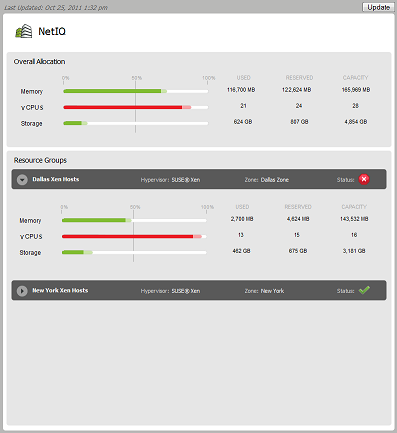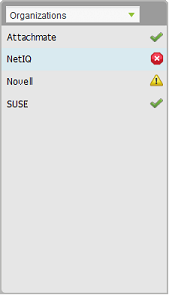NetIQ Cloud Manager 2.1.5
An Approver has rights to approve or deny a business service request based on the available resource capacity for the requesting organization or the hosting zone. This Quick Start explains how to perform Approver tasks in the Cloud Manager console. The information is also available in the Cloud Manager console under > > .
1.0 Approving Business Service Requests
After a business service request is submitted, an Administrator approval task is sent to you. This task allows you to review the business service and ensure that the resources requested for the business service are available.
-
On the main navigation bar, click
 , then click the tab.
, then click the tab.
-
If you want to claim the task so that no other administrators can work on it, select the task (the subject is ), then click .
The task is moved to your list.
-
Select the task in the list (either the list or the list), then click .
In the list, the column displays the zone and resource group that will host the deployed workload. The , , and columns display the requested resources for the workload.
If you are not sure that the resource group has sufficient available resources for the workload, close the dialog box and open the
 view. Select the organization for which the business service is being deployed, then select the resource group to see the available resource capacity.
view. Select the organization for which the business service is being deployed, then select the resource group to see the available resource capacity.

After verifying the requested resources against the available resources, open the task again.
-
When you have finished reviewing the task, select one of the following
-
: Approves the request.
-
: Denies the request. You can select a predefined reason for denying the request or provide a custom reason of your own. The Business Service Owner receives an e-mail that states the reason.
-
: Closes the task without approving or denying it.
-
2.0 Monitoring Resource Capacity
The Capacity view provides information about used, reserved, and allocated resource capacity for organizations and zones.
To open the Capacity view:
-
On the main navigation bar, click
 .
.
2.1 Understanding the Capacity View
The Capacity view includes three main sections: the Capacity Summary bar, the Organizations or Zones List, and the Details panel.
Capacity Summary Bar
The Capacity Summary bar provides a summary for the total resources within your management scope.

For example, if you are a Cloud Administrator, you see a summary for all of the resources in your Cloud. If you are a Zone Administrator, you see a summary of all of the resources in the zones you manage. If you are an Approver, you see a summary of all of the resources in your assigned organizations and zones.
Each resource (Memory, CPU, and Storage) has its own capacity indicator. The indicator displays the used and reserved capacity as a percentage of the total available capacity.
The color of the indicator is determined by the Warning and Problem thresholds set for the Cloud environment. Green indicates that no thresholds have been reached, yellow indicates that the Warning threshold has been reached, and red indicates that the Problem threshold has been reached.
The Issues section of the Capacity Summary bar shows the following:
-
 No resource issues.
No resource issues.
-
 The number of resources that have reached the Warning threshold.
The number of resources that have reached the Warning threshold.
-
 The number of resources that have reached the Problem threshold.
The number of resources that have reached the Problem threshold.
Organizations or Zones List
The Organizations or Zones list displays the organizations or zones for which you can view resource capacity.

Depending on your role, you might be able to see either organizations or zones but not both.
The icon next to each organization or zone indicates the current status of the resources for that item. The statuses correspond to the statuses that can be listed in the Capacity Summary bar:
-
 No resource issues.
No resource issues.
-
 One or more resources for the organization or zone have reached the Warning threshold.
One or more resources for the organization or zone have reached the Warning threshold.
-
 One or more resources for the organization or zone have reached the Problem threshold.
One or more resources for the organization or zone have reached the Problem threshold.
Organizations or Zones Details
The Organizations or Zones Details panel displays the resource capacity information for the organization or zone that is selected in the list.

The section provides a summary of the used, reserved, and available capacity for the entire organization or zone.
-
Used: The amount of the resource that is actually being consumed by deployed workloads. For example, a workload might be allocated 4 GB of memory but only be using 2 GB.
-
Reserved: The amount of the resource that is reserved for deployed workloads. For example, if a workload is allocated 4 GB of memory, all 4 GB are reserved.
-
Capacity: The total amount of the resource that is available for deployed workloads.
The sections provide capacity details for each resource group assigned to the organization or zone. The status of each resource group is also displayed.
The field displays the last time the capacity data was updated. The button lets you update the data.
2.2 Updating the Capacity Data
The Capacity engine collects capacity data on a regular interval specified in System Configuration. The collected data is cached on the Cloud Manager Application Server.
The Capacity data is static, meaning that the Capacity view displays the same data until you update from the cached data on the Cloud Manager Application Server.
To update the data:
-
Click .
If the cached data is newer than the current data, the Capacity view is updated with the cached data.
-
Click to confirm that you to continue with the manual update.
The Capacity engine collects the new data from the system. As soon as the data is collected, the Capacity view automatically updates to the new data.
3.0 Legal Notice:
THIS DOCUMENT AND THE SOFTWARE DESCRIBED IN THIS DOCUMENT ARE FURNISHED UNDER AND ARE SUBJECT TO THE TERMS OF A LICENSE AGREEMENT OR A NON-DISCLOSURE AGREEMENT. EXCEPT AS EXPRESSLY SET FORTH IN SUCH LICENSE AGREEMENT OR NON-DISCLOSURE AGREEMENT, NETIQ CORPORATION PROVIDES THIS DOCUMENT AND THE SOFTWARE DESCRIBED IN THIS DOCUMENT "AS IS" WITHOUT WARRANTY OF ANY KIND, EITHER EXPRESS OR IMPLIED, INCLUDING, BUT NOT LIMITED TO, THE IMPLIED WARRANTIES OF MERCHANTABILITY OR FITNESS FOR A PARTICULAR PURPOSE. SOME STATES DO NOT ALLOW DISCLAIMERS OF EXPRESS OR IMPLIED WARRANTIES IN CERTAIN TRANSACTIONS; THEREFORE, THIS STATEMENT MAY NOT APPLY TO YOU.
This document and the software described in this document may not be lent, sold, or given away without the prior written permission of NetIQ Corporation, except as otherwise permitted by law. Except as expressly set forth in such license agreement or non-disclosure agreement, no part of this document or the software described in this document may be reproduced, stored in a retrieval system, or transmitted in any form or by any means, electronic, mechanical, or otherwise, without the prior written consent of NetIQ Corporation. Some companies, names, and data in this document are used for illustration purposes and may not represent real companies, individuals, or data.
This document could include technical inaccuracies or typographical errors. Changes are periodically made to the information herein. These changes may be incorporated in new editions of this document. NetIQ Corporation may make improvements in or changes to the software described in this document at any time.
© 2013 NetIQ Corporation and its affiliates. All Rights Reserved.
U.S. Government Restricted Rights: If the software and documentation are being acquired by or on behalf of the U.S. Government or by a U.S. Government prime contractor or subcontractor (at any tier), in accordance with 48 C.F.R. 227.7202-4 (for Department of Defense (DOD) acquisitions) and 48 C.F.R. 2.101 and 12.212 (for non-DOD acquisitions), the government’s rights in the software and documentation, including its rights to use, modify, reproduce, release, perform, display or disclose the software or documentation, will be subject in all respects to the commercial license rights and restrictions provided in the license agreement.
Check Point, FireWall-1, VPN-1, Provider-1, and SiteManager-1 are trademarks or registered trademarks of Check Point Software Technologies Ltd.
Access Manager, ActiveAudit, ActiveView, Aegis, AppManager, Change Administrator, Change Guardian, Cloud Manager, Compliance Suite, the cube logo design, Directory and Resource Administrator, Directory Security Administrator, Domain Migration Administrator, Exchange Administrator, File Security Administrator, Group Policy Administrator, Group Policy Guardian, Group Policy Suite, IntelliPolicy, Knowledge Scripts, NetConnect, NetIQ, the NetIQ logo, PlateSpin, PlateSpin Recon, Privileged User Manager, PSAudit, PSDetect, PSPasswordManager, PSSecure, Secure Configuration Manager, Security Administration Suite, Security Manager, Server Consolidator, VigilEnt, and Vivinet are trademarks or registered trademarks of NetIQ Corporation or its affiliates in the USA. All other company and product names mentioned are used only for identification purposes and may be trademarks or registered trademarks of their respective companies.
For purposes of clarity, any module, adapter or other similar material ("Module") is licensed under the terms and conditions of the End User License Agreement for the applicable version of the NetIQ product or software to which it relates or interoperates with, and by accessing, copying or using a Module you agree to be bound by such terms. If you do not agree to the terms of the End User License Agreement you are not authorized to use, access or copy a Module and you must destroy all copies of the Module and contact NetIQ for further instructions.